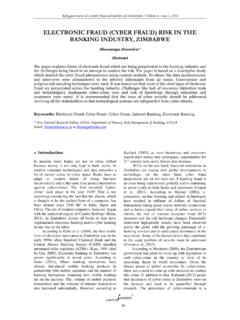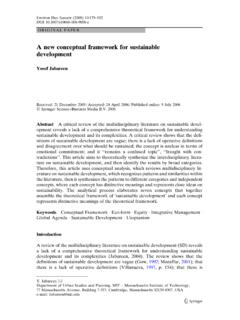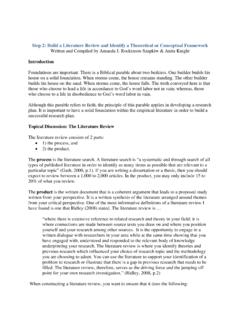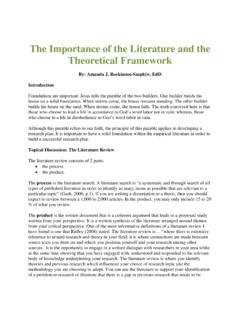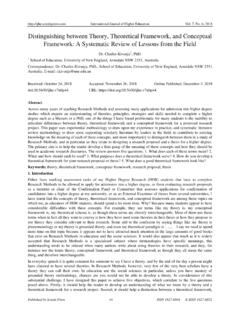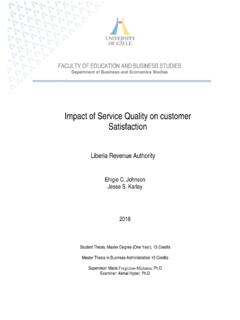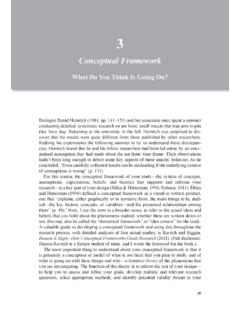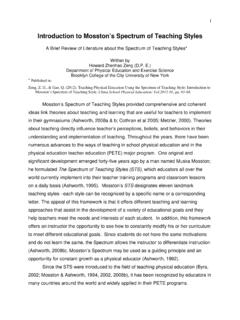Transcription of FOREIGN DIRECT INVESTMENT AND ECONOMIC GROWTH: A ...
1 Journal of Governance and Regulation / Volume 3, Issue 2, 2014 63 FOREIGN DIRECT INVESTMENT AND ECONOMIC GROWTH: A theoretical framework Edmore Mahembe*, NM Odhiambo** Abstract The relationship between FDI and ECONOMIC growth has attracted considerable attention over the years. Despite the important role played by FDI in ECONOMIC growth, a number of policy-makers have not fully understood the theoretical linkage between FDI and ECONOMIC growth. The aim of this paper, therefore, is to review the theoretical literature on the relationship between FDI and ECONOMIC growth in a stylized fashion. The theoretical literature reviewed in this study show that FDI is a key contributor to the ECONOMIC growth of the host country. FDI affects ECONOMIC growth through two broad channels: (i) FDI can encourage the adoption of new technologies in the production process through technological spillovers; and (ii) FDI may stimulate knowledge transfers, both in terms of labour training and skill acquisition, and also by introducing alternative management practices and better organisational arrangements.
2 Key Words: FOREIGN DIRECT INVESTMENT , ECONOMIC Growth, Technological Transfer * Department of Economics, University of South Africa, Box 392, UNISA, 0003, Pretoria, South Africa E-mail: ** Corresponding author, Department of Economics, University of South Africa, Box 392, UNISA, 0003, Pretoria, South Africa E-mail: 1. introduction Since the early 1980s, the world has witnessed a massive increase in the flow of FOREIGN DIRECT INVESTMENT (FDI). According to UNCTAD (2012) data, global FDI flows grew from US$50 billion in the early 1980s to US$ trillion in 2011. This increase in FDI flows has also attracted the attention of academics, who started investigating the impact of FDI on ECONOMIC growth in the mid-1990s. FDI is a composite package that includes physical capital, production techniques, managerial skills, products and services, marketing expertise, advertising and business organisational processes (Thirlwall, 1999 and Zhang, 2001b).
3 It is argued that FDI has important growth effects on host economies. In theory, FDI can boost the host country s economy via capital accumulation, the introduction of new goods, and FOREIGN technology (according to the Exogenous Growth-theory view). It can also enhance the stock of knowledge in the host country by the transfer of skills, according to the endogenous growth theory (Elboiashi, 2011). Herzer et al. (2008) highlight the fact that FDI plays an important function in the host country s ECONOMIC growth by increasing the amount of investable capital, and by way of technological spill-overs. The OECD (2002:5) also states that FDI represents a potential source for sustainable growth and development, given its assumed ability to: (i) Generate technology spill-overs; (ii) assist in human capital formation and development; (iii) help the host to integrate into the global ECONOMIC trade integration,; and (iv) assist in the creation of a more competitive business environment and enhance enterprise development.
4 This paper aims to review the existing literature on FDI and ECONOMIC growth, emphasising both the theoretical frameworks and the empirical evidence. Unlike the previous studies, this paper clearly explains the channels through which FDI can affect ECONOMIC growth. Through this analysis, the paper illustrates why empirical results are mixed. The paper is divided into four sections. Section two offers a brief overview of the theoretical relationship between FDI and ECONOMIC growth using the exogenous and endogenous growth models; while Section three presents channels or mechanisms through which FDI can affect ECONOMIC growth. Finally, section four presents some concluding remarks. 2. FDI and ECONOMIC Growth: A Review of the theoretical Models Linkages between FDI and growth in the exogenous-growth model The exogenous-growth theory, usually referred to as the neo-classical growth model or the Solow-Swan growth model, was pioneered by Solow (1956 and 1957).
5 The theory assumes that ECONOMIC growth is Journal of Governance and Regulation / Volume 3, Issue 2, 2014 64 generated through the accumulation of exogenous factors of production, such as the stock of capital and labour. Empirical studies on ECONOMIC growth using the exogenous model normally employ the aggregate-production function, as developed by Cobb and Douglas (1928). Following Hicks (1932), the Cobb-Douglas production function, or the aggregate-production function is modelled against: capital input (both domestic and FOREIGN ), labour input, and the rate of technological progress, which changes over time3. It has been shown that through this framework , capital accumulation contributes directly to ECONOMIC growth in proportion to capital s share of the national output.
6 Furthermore, the growth of the economy depends on the augmentation of the labour force and technological progress. According to this theory, FDI increases the capital stock in the host country; and this would, in turn, affect ECONOMIC growth. De Jager (2004) explains that if FDI introduces new technology, which leads to increased labour and capital productivity, this would then lead further to more consistent returns on INVESTMENT , and labour would grow exogenously. Barro and Sala-I-Martin (1995)4 demonstrated that there is a positive relationship between capital accumulation and output; while Herzer, et al. (2008) have recently established that FDI stimulates ECONOMIC growth by augmenting domestic INVESTMENT . Through the exogenous or neo-classical growth model, it has been shown that FDI can impact ECONOMIC growth directly through capital accumulation and the inclusion of new inputs and FOREIGN technologies in the production function of the host country.
7 Thus, the neo-classical growth model shows that FDI promotes ECONOMIC growth by increasing the amount and/or the efficiency of INVESTMENT in the host country. Linkages between FDI and growth in the endogenous growth model Unlike neoclassical growth models, which assume technological progress to be exogenous, the new growth models5 postulate that ECONOMIC growth is driven by two main factors: the stock of human capital and technological changes (Romer, 1986, 1990 and 1994; Lucas, 1988). Nair-Reichert and Weinhold (2001:154) argue that the new endogenous growth models take into account long-run growth as a function of technological progress; and hence they offer a framework in which FDI can perpetually increase the rate of ECONOMIC growth in the host country via technology transfer, diffusion, and spill-over effects.
8 3 Following Hicks (1932), a technological innovation is Hicks neutral if the ratio of marginal product of capital to marginal product of labour is unchanged for a given capital-to-labour ratio. That is, Y = A*f(K,L) 4 Quoted from Elboiashi (2011). 5 Commonly referred to as the endogenous growth theory. Although both the exogenous and endogenous growth theories argue that capital accumulation or formation is an important determinant of ECONOMIC growth, they differ in their treatment of technological progress. The former treats technological progress as exogenous to the model; while the latter argues that technological progress is improved endogenously by the increase in knowledge and innovation (Borensztein et al.)
9 , 1998; de Mello, 1999; Elboiashi, 2011 and Al Nasser, 2010). FDI by multinational corporations (MNCs) is assumed to bring research and development (R&D), in addition to human capital accumulation, which creates positive or negative externalities (growth spill-overs), which would affect the host country s firms and the economy (Barro and Sala-I-Martin, 1995). These growth factors, or FDI spill-overs, are assumed to arise from tangible capital, human capital, or R&D development expenditures. The two growth theories and the FDI- ECONOMIC growth illustration above reveal that FDI can contribute to ECONOMIC growth through both DIRECT impact and indirect impact. In theory, FDI can boost the host country s economy via capital accumulation, the introduction of new goods and FOREIGN technology (according to the exogenous-growth theory view), and also by enhancing the stock of knowledge in the host country by way of the transfer of skills according to the endogenous growth theory (Elboiashi, 2011).
10 Herzer et al. (2008) highlight the fact that FDI plays an important role in the host country s ECONOMIC growth by increasing the amount of investable capital, and by way of technological spill-overs. The OECD (2002:5) further elucidates that FDI represents a potential source for sustainable growth and development, given its assumed ability to: (i) Generate technology spill-overs; (ii) assist in the formation of human capital and development; (iii) help the host to integrate into global ECONOMIC trade integration; and (iv) assist in the creation of a more competitive business environment and enhance enterprise development. 3. Channels through which FDI impacts on ECONOMIC growth The theoretical and empirical literature offer contradictory predictions on the effects of FDI on the host country s economy.

